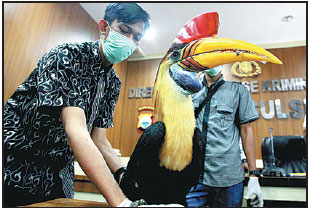Craze for hornbill 'ivory' pushes bird to brink in Borneo
A striking bird with monochrome plumage and a formidable "beak", the helmeted hornbill is being hunted to extinction, one of the latest victims of a thriving global trade in exotic wildlife.
For decades poachers in Borneo's western forests focused on capturing orangutans and sun bears, but in the past few years a surge in demand for hornbill "ivory" has pushed the avian species to the brink.
The product has become so popular - wealthy collectors are keen to show off their status by acquiring rare or unusual animals - it is fetching up to five times the price of elephant tusk on the black market.
"The demand for these luxury items is just going through the roof," said Chris Shepherd, from wildlife trade watchdog TRAFFIC.
"In Asia, it's really at a scale where species like the helmeted hornbill are just being completely decimated."
Poachers aren't interested in their brilliant plumage or large bills, but a helmet-like block of reddish-gold keratin at the front of the skulls known as a casque.
It's this soft, ivory-like substance that's carved by craftsmen into luxury ornaments, statues and jewelry - trendy top-shelf trinkets that have soared in value as so-called "red ivory" has grown more prestigious.
Experts say a single casque can fetch up to $1,000, eclipsing the average black market price of traditional "white" ivory sourced from elephant tusk several times over.
Researchers say thousands of these majestic birds have been killed in half a decade alone as demand for red ivory has taken off.
Yokyok Hadiprakarsa, a leading expert in helmeted hornbills, estimates as many as 500 were killed every month in 2013 - or 6,000 annually - just in West Kalimantan, a jungle-clad province in Indonesia's half of Borneo.
Helmeted hornbills had been traditionally hunted in the past by Borneo's indigenous tribes, but never at levels that posed any conservation risk.
This "complete, systematic slaughter of the species" came virtually out of nowhere, Shepherd said. It wasn't until 2011 that red ivory first began showing up on websites catering to buyers in Asia and at high-end wildlife markets along the country's borders, such as in Myanmar and Laos.
By the close of 2015, the species had progressed from vulnerable to critically endangered - leapfrogging two threat levels to the highest possible risk category on the International Union for Conservation of Nature's "red list".
|
Plainclothes police display a stuffed hornbill trophy seized from smugglers in Makassar, South Sulawesi province. The bird is being hunted to extinction, according to wildlife officials.AFP |



















